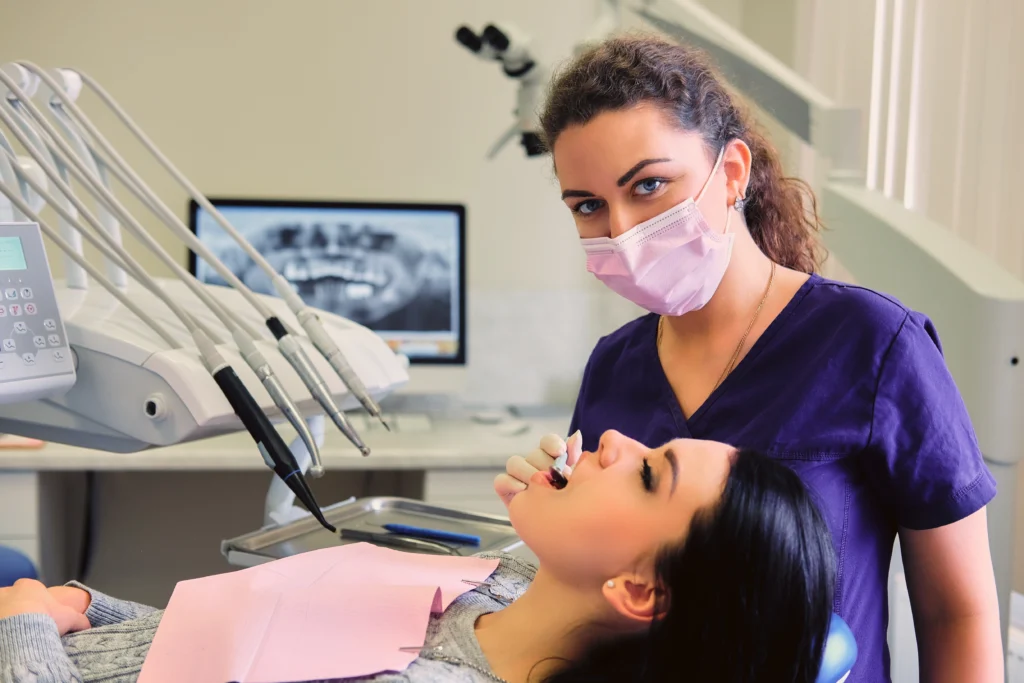Teeth whitening is one of the most sought-after cosmetic dental treatments today. It helps individuals achieve a whiter and more confident smile. Since teeth tend to turn yellowish or discolour with ageing due to coffee, tea, red wine, or smoking, professional teeth whitening can offer fast and effective results.
Let’s explore different types of professional teeth whitening methods. We are going to have a look at options like hydrogen peroxide teeth whitening, laser teeth whitening, Zoom teeth whitening, and Polanight teeth whitening, among others.
What is Professional Teeth Whitening?
Professional teeth whitening is done by a dentist. The bleaching agent used is more intense compared to the ones available over the counter. This will make the whole process quicker and more effective. The results can last longer, and the treatment is safer if done professionally after taking all the precautions. There are several methods of professional teeth whitening. Let’s take a closer look at each option.
Hydrogen Peroxide Teeth Whitening:
Hydrogen peroxide has always been an ingredient of teeth whitening products. It is a bleaching agent that helps in removing stains or any discolouration from the surface of the teeth. In professional treatments, a higher concentration of hydrogen peroxide is used than in self-administering products.
In the teeth whitening procedure, the Dentist applies a gel containing hydrogen peroxide or its precursor carbamide peroxide to the teeth. A special light sometimes is used to activate the gel action. The process takes about an hour. Results can be immediate, and this whitens the teeth by several shades.
Laser Teeth Whitening:
Another professional method is laser teeth whitening. This process is similar to hydrogen peroxide whitening, but it includes a laser. The Dentist will apply some bleaching gel to the teeth and then apply a laser to the teeth to help activate the gel. The laser basically accelerates the breakdown of stains on the teeth faster.
Laser teeth whitening is quick and effective. It can whiten the teeth up to several shades after just one treatment. The procedure does not cause any pain. Some may still experience sensitivity that lasts only for a short period of time. Therefore, laser teeth whitening is best for those who want immediate results. Since laser teeth whitening involves applying gels with higher concentrations of Hydrogen Peroxide, it is important to protect the surrounding tissues. Gums and other structures are protected with the help of rubber dam and other protective mediums.
Zoom Teeth Whitening:
Zoom teeth whitening is a popular way to whiten teeth. It uses a light and a gel to rapidly whiten the teeth. It typically takes 45 minutes to an hour to perform. First, your gums and lips are protected. Secondly, whitening gel is applied to your teeth. The light then activates the gel to whiten the teeth. This process is repeated several times. With Zoom, your teeth can be whitened up to 8 shades. Zoom teeth whitening is a fast and effective procedure. It is recommended for those who want their teeth whitened in one appointment. You can also have this procedure done at home. Make sure to check with your dentist which option is best for you.
Polanight Whitening of the Teeth:
Polanight teeth whitening is a professional at-home whitening treatment. The material uses a whitening gel containing carbamide peroxide. Carbamide peroxide is a molecule that later breaks down into hydrogen peroxide. The dentist fabricates custom trays designed to fit tightly over the teeth. The patient fills the tray with the Whitening Gel Polanight and wears it for some hours or overnight. The advantage of the Polanight teeth whitening technique lies in the fact that it gives the patient the liberty to whiten their teeth from the comfort of their own homes. The results of this method are gradual and would be visible in a few days or up to a couple of weeks. This is suitable for the kind of person who likes more flexibility with their whitening schedule.
Whitening Spots on Teeth:
Some people have specific spots on their teeth that are much more discoloured compared to the rest. These could be due to enamel hypoplasia, fluorosis, or demineralisation. Whitening spots on the teeth are always quite challenging to correct. The discolouration in such cases is often deeper than surface stains.
Various types of such spots are treated by dentists through different techniques. The common method includes micro abrasion. It involves a gentle removal of a thin layer of enamel to even out the colour. Other options include spot whitening of teeth by applying a higher concentration of bleaching agent.

